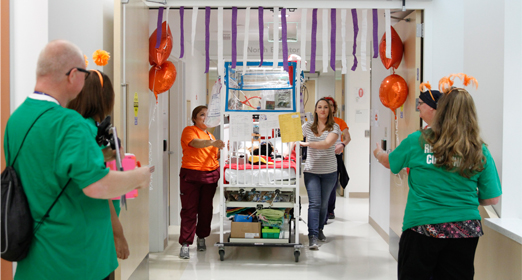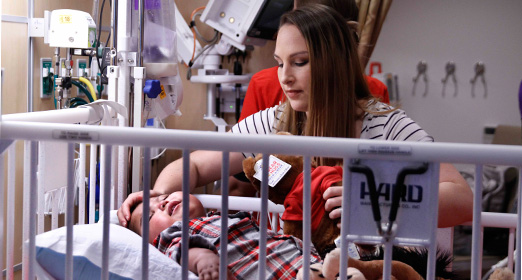For 2-year-old Cameron Harris, Lucile Packard Children’s Hospital Stanford is the only home he’s ever known. He has moved rooms a few times and been on different units, but on December 9, 2017—the 525th day of his latest inpatient stay—he made his biggest move yet.
At 11:04 a.m., Cameron started his ride down the hall in his crib, covered in a cozy red blanket announcing “I opened the doors,” and accompanied by his mom and his nurses. At the end of their journey, they broke through a red ribbon to arrive in Cameron’s sunny, private room in the brand-new, state-of-the-art expansion of Lucile Packard Children’s Hospital Stanford.
“I’ve watched this amazing hospital be built next door over the last two years, and I’ve been chomping at the bit to get in there!” said Cameron’s mom, Nicola Harris, the day before the move. “I hear there’s amazing technology and play spaces for the kids. I just can’t wait to see it and experience it and be one of the first families to be there.”
When her son is in the hospital, Nicola is in the hospital, too. She’s spent most of the past two and a half years here, along with two of Cameron’s five siblings, 4-year-old Karlene and 16-month-old Alivia. The girls attend preschool in the hospital’s dayroom three days a week and keep their brother entertained. “The girls really encourage Cameron to move forward and try new things,” said Nicola. “If they weren’t here, he’d be happy to just lie in bed. But seeing them walk and explore the room and play with toys encourages him to get up and try those things too.”
Nicola never thought she’d be raising three of her six kids in a hospital. Her husband, CJ, parents their three older children at the family’s home in Arizona. Though they come to visit on every school break, “it’s been quite difficult,” said Nicola. “I’m away from half my family. But being here for so long, the staff has become our family, and the doctors. Everybody has played such an integral role in helping me and my family raise three babies here.”
It was during her pregnancy with Cameron that Nicola first learned her fetus had a life-threatening heart defect called hypoplastic left heart syndrome, meaning the left side of his heart was severely underdeveloped. She traveled from her home, then in Sacramento, to Lucile Packard Children’s Hospital Stanford about a month before Cameron’s due date to prepare for his medical needs at birth and to have his heart condition treated soon after.
When he was 5 days old, Cameron underwent the first step of his heart repair in a surgical procedure called the Norwood. The Betty Irene Moore Children’s Heart Center at Lucile Packard Children’s Hospital is one of the very few centers in the United States capable of performing the complex surgical procedures that Cameron needed to survive.
In the first eight months of life, Cameron would endure two open-heart surgeries, pioneering treatment for pulmonary hypertension, and numerous complications. He was able to go home for about three months in the spring of 2016. But during a surgery to place a gastrointestinal tube, his complications required critical support. “And that was the beginning of our stay: July 3, 2016,” said Nicola. “We’ve been here since.”
Cameron spent 129 days in the cardiovascular intensive care unit (CVICU) that summer. During that time, Nicola gave birth to her youngest daughter, Alivia, right down the hall at the Johnson Center for Pregnancy and Newborn Services. Alivia had complications at birth and spent a short time in the neonatal intensive care unit (NICU). “At that point, I had two different kids in two different units in this hospital—one in the CVICU and one in the NICU,” said Nicola.
Although Cameron recovered, his fragile heart was struggling to keep up through the complications and infections. His doctors and family decided to put him on the waiting list for a heart transplant. “We spent 255 days waiting for a heart here in PCU 374, room 3752,” said Nicola. “The majority of the time we’ve been here, we’ve been right in this room.”
New Heart, New Hospital
Cameron’s heart transplant finally came on July 22, 2017. “It was one of the best days of our entire life,” said Nicola. “He finally had his opportunity to really live life, to have this gift of life, life outside of these walls with his siblings and family, and to do just normal kid things.”
By December, just days before the opening of the new hospital expansion, Cameron was healthy enough to be moved from the CVICU to the step-down unit, back into his familiar room 3752, in what is now called the West building. It was from that room that Cameron and his mom prepared to make the next big step in his journey to his room in the new hospital expansion, now called the Main building.
“Private rooms!” Nicola said. “I’m really looking forward to private rooms. The fact that they’re private means I can have the girls more comfortably in the room and not worry about whether we’re disturbing someone else.” As someone who has eaten hospital food for the past two years, Nicola also expects to be the true test of whether the food in the Main building is as amazing as she’s heard. “I can’t wait to see what options they have for us, all the new tastes and smells.”
With everything to look forward to in the Main building, Nicola still treasures the support and comfort she’s found within the walls of the West building. “I love it so much here, and I’m excited to see everything new,” she said. “But it’s bittersweet, because I’m leaving my home in a sense. I truly believe it will be amazing, and so much of what I love here is going to be expanded there. I know I’ll find just as much love and encouragement and support and family and home there.”
As Nicola and Cameron began their journey to the Main building on December 9, they were accompanied by a few of the staff members they’d come to trust as family. Positioned along the hallways, transition team members in color-coded T-shirts helped direct the time-sensitive transition of 91 inpatients—one every four minutes—into the new units of the Main building. Every move was meticulously timed and monitored from the Command Center on the first floor of the Main building. Transport teams had rehearsed mock moves in the days leading up to the real move. For the most fragile patients, whole teams practiced with specific equipment and prepared to address any irregularities.
The result? “It was breathtaking,” said Nicola, relaxing in her son’s spacious new room with a view out the eastern side of the building, while Cameron slept quietly. “It went so smoothly. A well-oiled machine.” The staff had everything ready and helped prepare Cameron well ahead of time. “So he just had a happy day, happy morning,” Nicola added. “He just loved traveling the halls. All the things I was worried about he just smiled right through.”
As they crossed the threshold into the new Main building, Nicola noticed the sea creatures painted on the ceilings and the new photos and art on the walls.
“It’s beautiful, it’s gorgeous,” she said. “He’s going to have so much room to play with his sisters. They have space that can be their space, and he has space that can be his. It’s just going to be more like home.” With two televisions in the room, “Cameron can watch what he wants, and I can have the sisters watch what they want, and there’ll be no more fighting. For me, it’s the simple little things that just make it better.”
Room for Healing with Family
Next to the Command Center, the Harvest Café in the Main building was already sending out the aroma of fresh pizza from the wood-fired oven, along with a wide buffet selection of gourmet choices. A grand piano played live music above the expansive lobby, which centers around the giant “redwood” elevator corridor.
Colorful mosaics of the California coastline decorate the floor. Down the hall, the Sanctuary offers a secluded, quiet spot to rest and reflect. Animal-themed play structures and sculptures are everywhere. The Main building is a place where anyone could grow very comfortable.
“For his holiday season, Cameron’s whole family will be here—myself, his dad, all of his four sisters and brother will be here,” said Nicola. “And we’re all looking forward to spending this holiday in the new hospital, playing and gathered around one another and really enjoying each other’s time.”
Lots of time with family is exactly what Cameron needs most as he prepares to transition home. “After more than 500 days in the hospital, the transition to being an outpatient will be huge,” said Sharon Chen, MD, pediatric cardiologist. “We hope he’ll be able to make that transition in the next few weeks. Being in the new hospital, in a more spacious, family-friendly room, will allow them to spend more time together doing his hands-on care to prepare for his transition home.”
Nicola took a moment to reflect on the many hundreds of donors who made the hospital possible and what message she had for them. “Thank you is not enough,” she said. “There are not enough words to express our gratitude. The environment that the donations have allowed the teams at Packard to create to make living in the hospital that much better, and make the diagnostics that much better, it’s just: thank you. Thank you a million times over. It’s amazing. And it’s appreciated by every family.”
As Cameron advances on his way to recovery, there will be nothing quite like being in his own home for the first time. “It feels refreshing,” said Nicola. “It feels like a new start. Cameron is in a great place in his journey, and this new step feels like a potential end to a long story. And what a great way to be sent on our way, starting in a new hospital.”
This article originally appeared in the Winter 2017/2018 issue of Packard Children’s News.
Photographs by Paul Sakuma.

